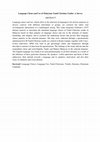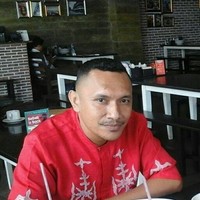JOURNAL ARTICLES by Angela Rumina Leo

Asian Englishes, 2021
In light of the historic linguistic vibrancy, Manglish, the unique Malaysian patois, emerges as a... more In light of the historic linguistic vibrancy, Manglish, the unique Malaysian patois, emerges as a survivor through the hybridization of its words, expressions, and idioms that consists of local languages. The de facto national code of Malaysia, with all its creativity & complexity is exhibited as aversive to Standard English. This study explored the position of the colloquial variety as a creole by accentuating its significance in the global context on the grounds of socio-cultural and socio-economic history, further encouraging the glocalization of the English language. A mixed qualitative-quantitative method was adopted for this research and data was obtained by investigating Malaysian private university undergraduates’ attitude towards Manglish by means of online survey questionnaires and semi-structured interviews. The findings indicate that a large majority of young Malaysians are positive towards Manglish, signalling survival through the test of time, yet it demands due recognition as a creole due to its heritage value.

JHSSR Special Issue on COVID-19, 2020
The turbulent times of the Coronavirus crisis, is a world-changing episode that keeps every singl... more The turbulent times of the Coronavirus crisis, is a world-changing episode that keeps every single adult on the planet pondering not only on the silhouette of the new black but also on the mushrooming metaphors. As a linguistic representation emerging upon a shift in word or phrase usage at the unexpected context of occurrence, the metaphor thereby causes semantic tension. Nevertheless, the gazetted metaphors in the mainstream English newspapers amid the nationwide Movement Control Order (MCO) in Malaysia is distinctive. Implementing the Pragglejaz’s Metaphor Identification Procedure, this study attempts to highlight and reveal its figurative meaning. In order to yield a comprehensive elucidation of these conceptual expressions; the analytical framework of this study constitutes a combination of the linguistic, cognitive, and pragmatic standards to rationalize these metaphors. The data of this study is analysed via a three-stepped Critical Metaphor Analysis that comprises metaphor identification, metaphor interpretation, and metaphor explanation.

IARS' International Research Journal, 2020
Reproductive health is an emerging issue in developing countries. The United Nations Population F... more Reproductive health is an emerging issue in developing countries. The United Nations Population Fund (UNFPA) reports that every minute, a woman in the developing world dies from treatable complications of either pregnancy or childbirth. Nigeria is a country where the state of reproductive health of its population is dismal. In 2012, UNFPA pointed out that Nigeria has one of the worst maternal mortality statistics in the world with a maternal mortality ratio of 545 per 100,000 live births. Several NGOs around the world deliver services at various levels to advocate the right of mothers to have safe births as well as address the shortage of skilled midwives. In this context, Malaysia has done much to control its infant and maternal mortality rates, through its community reproductive health initiatives. This study then aims to determine the communication norms in two NGOs, one in Malaysian and the other in Nigeria. The analysis was of projects undertaken by two NGOs, the Federation of Reproductive Health Association of Malaysia (FRHAM) and the Association for Reproductive and Family Health (ARFH) of Nigeria. The communication norms and ways of getting the community involved in their projects were examined through progress reports, document review and web searches. Besides being interviewed, questionnaires were filled by the employees of the NGOs. The findings indicate that the Nigerian and Malaysian NGOs have different communication models and they can learn from each other's best practices.

Frontiers of Language and Teaching, 2013
Language choice and use, which refers to the selection of language(s) for diverse purposes in div... more Language choice and use, which refers to the selection of language(s) for diverse purposes in diverse contexts with different individuals or groups, are common but rather vital sociolinguistic phenomena in a multilingual setting. This study integrates Fishman’s (1972) domain analysis to determine the dominant language choice of Tamil Christian youths in Malaysia based on their patterns of language choice and use in the domains of family, friendship, and religion; and to examine the underlying factors that govern their language choice patterns in the selected domains. The data were collected through a questionnaire administered to 60 Tamil Christian youths at a church in Kuala Lumpur; together with 4 face-to-face interviews. SPSS was used to get percentage values and frequencies through descriptive statistics of data from the questionnaire. The findings of the study indicate that the respondents chose and used English, Tamil, and Bahasa Malaysia in the selected domains. The English language was found to be used predominantly in all three domains as a result of the influence of these particular domains; the speakers’ verbal repertoires and those of their addressees; their attitude towards a language and its speakers; motivation; and also their sense of solidarity and social identity.
Keywords: Language Choice, Language Use, Tamil Christians, Youths, Domains, Dominant Language
BOOK CHAPTERS by Angela Rumina Leo
Redesigning Assessment for Holistic Learning: A Quick Guide for Higher Education , 2018
The “Patchwork” is a form of innovative assessment for learning; in line with the positive shift ... more The “Patchwork” is a form of innovative assessment for learning; in line with the positive shift towards holistic learning in the academic arena, which thrives to cater to the demands of the increasingly volatile, uncertain, complex, and ambiguous world. This incredible emancipatory assessment draws attention on experiential learning where inclusivity and student-ownership within the real-world context hail as the central focus in ensuring the occurrence of deep learning by roping in continuous reflection and feedback practices through self and peer assessments.
Keywords: continuous reflection, deep learning, feedback, inclusivity, student-ownership
POSTERS by Angela Rumina Leo
Redesigning Assessment for Holistic Learning RAHoLE, 2017
CONFERENCE PROCEEDINGS by Angela Rumina Leo

Globalization, Culture and Society: What role does language play?, Jul 1, 2013
Blended learning focuses on combining a specific percentage of online curriculum and instruction ... more Blended learning focuses on combining a specific percentage of online curriculum and instruction in a face-to-face setting. In this study, the adoption of Facebook as an additional tool in teaching communicative English skills to prepare international students from non-English speaking countries for tertiary education in Malaysia is discussed; based on the Leapfrog Principle. The study aims to investigate the effectiveness of Facebook as a language teaching tool in Immersion English courses and examine the role of Facebook in new learning spaces and with today’s learners. Data for the study was collected via a teacher’s teaching journal followed by a recorded interview conducted with ten students in the pre-intermediate level; at the Limkokwing English Centre. The analysis of the data was done qualitatively. The findings of the study indicated that Facebook is perceived as an effective teaching means; in terms of both delivery and pedagogy in an Immersion English course. It is also believed to cater to a flexible and motivating language learning environment for the current day youths. In short; the integration of Facebook into the intensive English as a Foreign Language (EFL) course for adult learners, enriches the teaching-learning experiences.
Papers by Angela Rumina Leo

Language choice and use, which refers to the selection of language(s) for diverse purposes in div... more Language choice and use, which refers to the selection of language(s) for diverse purposes in diverse contexts with different individuals or groups, are common but rather vital sociolinguistic phenomena in a multilingual setting. This study integrates Fishman's (1972 domain analysis to determine the dominant language choice of Tamil Christian youths in Malaysia based on their patterns of language choice and use in the domains of family, friendship, and religion; and to examine the underlying factors that govern their language choice patterns in the selected domains. The data were collected through a questionnaire administered to 60 Tamil Christian youths at a church in Kuala Lumpur; together with 4 faceto-face interviews. SPSS was used to get percentage values and frequencies through descriptive statistics of data from the questionnaire. The findings of the study indicate that the respondents chose and used English, Tamil, and Bahasa Malaysia in the selected domains. The English language was found to be used predominantly in all three domains as a result of the influence of these particular domains; the speakers' verbal repertoires and those of their addressees; their attitude towards a language and its speakers; motivation; and also their sense of solidarity and social identity.
Alternative Assessments in Malaysian Higher Education, 2022

Language choice and use, which refers to the selection of language(s) for diverse purposes in div... more Language choice and use, which refers to the selection of language(s) for diverse purposes in diverse contexts with different individuals or groups, are common but rather vital sociolinguistic phenomena in a multilingual setting. This study integrates Fishman’s (1972 domain analysis to determine the dominant language choice of Tamil Christian youths in Malaysia based on their patterns of language choice and use in the domains of family, friendship, and religion; and to examine the underlying factors that govern their language choice patterns in the selected domains. The data were collected through a questionnaire administered to 60 Tamil Christian youths at a church in Kuala Lumpur; together with 4 face-to-face interviews. SPSS was used to get percentage values and frequencies through descriptive statistics of data from the questionnaire. The findings of the study indicate that the respondents chose and used English, Tamil, and Bahasa Malaysia in the selected domains. The English la...

IARS' International Research Journal
Reproductive health is an emerging issue in developing countries. The United Nations Population F... more Reproductive health is an emerging issue in developing countries. The United Nations Population Fund (UNFPA) reports that every minute, a woman in the developing world dies from treatable complications of either pregnancy or childbirth. Nigeria is a country where the state of reproductive health of its population is dismal. In 2012, UNFPA pointed out that Nigeria has one of the worst maternal mortality statistics in the world with a maternal mortality ratio of 545 per 100,000 live births. Several NGOs around the world deliver services at various levels to advocate the right of mothers to have safe births as well as address the shortage of skilled midwives. In this context, Malaysia has done much to control its infant and maternal mortality rates, through its community reproductive health initiatives. This study then aims to determine the communication norms in two NGOs, one in Malaysian and the other in Nigeria. The analysis was of projects undertaken by two NGOs, the Federation of ...










Uploads
JOURNAL ARTICLES by Angela Rumina Leo
Keywords: Language Choice, Language Use, Tamil Christians, Youths, Domains, Dominant Language
BOOK CHAPTERS by Angela Rumina Leo
Keywords: continuous reflection, deep learning, feedback, inclusivity, student-ownership
POSTERS by Angela Rumina Leo
CONFERENCE PROCEEDINGS by Angela Rumina Leo
Papers by Angela Rumina Leo
Keywords: Language Choice, Language Use, Tamil Christians, Youths, Domains, Dominant Language
Keywords: continuous reflection, deep learning, feedback, inclusivity, student-ownership